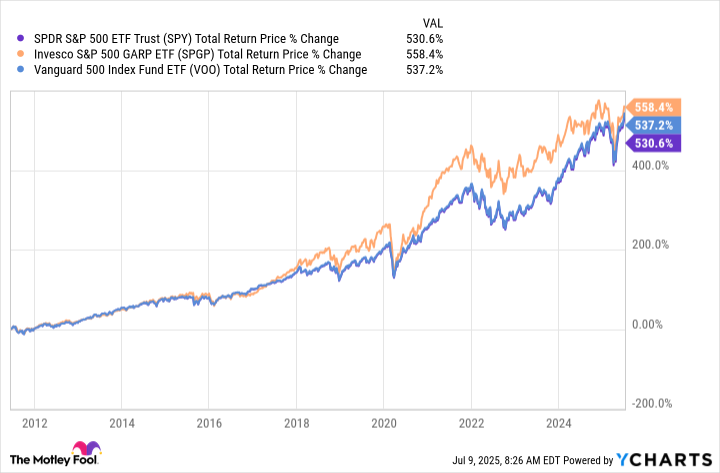The S&P 500 is what just about everyone uses to monitor the performance of the U.S. stock market. That makes sense given its broad representation of the U.S. economy, but does that mean it is the smartest way to invest in stocks?
Maybe, maybe not, depending on what your personal investment approach and goals look like. For many, the Invesco S&P 500 GARP ETF (SPGP 0.56%) could be a better option. Here's why.
What exactly does the S&P 500 track?
The S&P 500 is a collection of roughly 500 stocks that are selected by a committee. Each stock is expected to be important to its industry, which generally means they are large companies. The overall list of around 500 stocks is also expected to be broadly representative of the U.S. economy.
While this approach ultimately creates an index that can be used to track the performance of the U.S. stock market, the real goal is slightly different. That's notable when you look at what the S&P 500 offers for investors looking to take a more nuanced investment approach. Essentially, the index is just a quick list of large and economically important companies.
That can provide the foundation for other investment approaches. For example, the SPDR Portfolio S&P 500 High Dividend ETF uses the 500 stocks in the index as a starting point for picking high-yield stocks. There are other ETFs that create value and growth portfolios from the index. But the Invesco S&P 500 GARP ETF might be the most interesting of all.

Image source: Getty Images.
What does the Invesco S&P 500 GARP ETF do?
The Invesco S&P 500 GARP ETF starts out by looking at the S&P 500's stocks. It examines sales-per-share growth, earnings-per-share growth, price-to-earnings ratios, financial leverage, and return on equity with the goal of finding attractively priced stocks that have growing businesses backing them. Around 75 stocks get into the index that the GARP ETF tracks.
SPY Total Return Price data by YCharts.
The end result is a portfolio that has outperformed two of the most popular S&P 500 index ETFs, the SPDR S&P 500 ETF and the Vanguard S&P 500 ETF. To be fair, the performance difference isn't huge, but over time this type of small difference can start to add up. More to the point, buying the Invesco S&P 500 GARP ETF aims to home in on the most attractive stocks in the index.
The Invesco S&P 500 GARP ETF won't be right for every investor. For example, the dividend yield is a fairly modest 1.5%. While that's slightly more than the S&P 500 index's roughly 1.3%, it pales in comparison to the SPDR Portfolio S&P 500 High Dividend ETF's 4.5% payout.
If income is your goal, you probably won't want to own the Invesco S&P 500 GARP ETF. But if buying a collection of large, economically important, and attractively priced companies with strong growth prospects sounds good, the Invesco S&P 500 GARP ETF could be perfect.
The problem with the Invesco S&P 500 GARP ETF
That said, there is one small problem with the Invesco S&P 500 GARP ETF. Its 0.36% expense ratio is rather high for an exchange-traded fund. Yet, based on its outperformance, it seems like the ETF has easily earned the right to charge a premium price.
With the market near all-time highs today, it might make sense to skip the S&P 500 index fund and buy the more focused Invesco S&P 500 GARP ETF, which appears to have mixed value and growth into an attractive index alternative.



